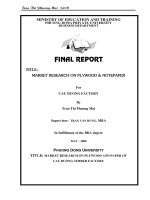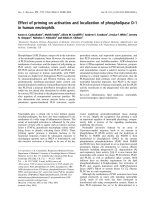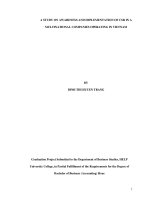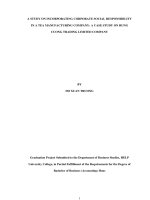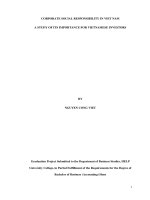research on awareness and implementation of corporate social responsibility in a multinational company in vietnam case study nestle vietnam
Bạn đang xem bản rút gọn của tài liệu. Xem và tải ngay bản đầy đủ của tài liệu tại đây (610.79 KB, 73 trang )
RESEARCH ON AWARENESS AND IMPLEMENTATION
OF CORPORATE SOCIAL RESPONSIBILITY IN
A MULTINATIONAL COMPANY IN VIETNAM
CASE STUDY: NESTLE VIETNAM
BY
TRUONG THI THU THANH
Graduation Project Submitted to the Department of Business Studies, HELP
University College, in Partial Fulfillment of the Requirements for the Degree of
Bachelor of Business (Accounting) Hons
OCTOBER 2011
1
October 2011
Declaration of Originality and Word Count
DECLARATION
I hereby declare that this graduation project is based on my original work except for
quotations and citations which have been duly acknowledged. I also declare that it
has not been previously or concurrently submitted for any other courses/degrees at
HELP University College or other institutions.
Word Count: 11,725 words
TRUONG THI THU THANH
Date: 28/10/2011
2
Acknowledgements
As a student, our main responsibility is to absorb and learn as much as we can from
the assistance, support and encouragement of many people such as our mentors and
teachers around us. They help us to learn, to apply our knowledge and to grow. And
this project would not have been made without them. I wish to take this opportunity
to thank all the people who have guided me in the right direction and kept me
motivated during the time of completing the dissertation.
First and foremost I would like to express my deep gratitude to my supervisor, Dr Le
Van Lien from International School at Vietnam National University, Hanoi who
guide me in my choice of assignment. His guidance throughout and inspiration for
me to create new ideas has helped me to learn and grow personally.
I also would like to express my thank to Ms. Sumathi and Ms. Shenba at Help
University College, who initiated the project and give so much instruction and
support.
3
Abstract
RESEARCH ON AWARENESS AND IMPLEMENTATION
OF CORPORATE SOCIAL RESPONSIBILITY IN
A MULTINATIONAL COMPANY IN VIETNAM
CASE STUDY: NESTLE VIETNAM
By
TRUONG THI THU THANH
October 2011
Supervisor: Dr. Le Van Lien
Corporate Social Responsibility (CSR) has become even more important for the
developing countries. It has developed through the long history and nowadays many
business entities over the world want to carry out the CSR in their business
operation. Vietnam is one of the world‟s fastest-growing economies. Therefore, there
are many multinational companies want to invest in Vietnam market. This paper
aims to discover the awareness of multinational organizations in Vietnam on CSR,
and the consumer attitude to social responsibility is positive or not. Besides, another
objective understands the implementation, CSR reporting of CSR in a multinational
company operating in Vietnam by asking respondents‟ understanding and opinion.
From conducting research, it can show the understanding and awareness of CSR
concept of multinational companies operating in Vietnam is unlimited, but the
performance is limited. The multinational companies have found difficult to use CSR
as a tool to value companies, the implementation of CSR in Vietnam as much as they
4
can, and especially have to according with law and environmental protection and
better community in Vietnam. Willingness to learning and gaining more knowledge
about CSR found from the survey has drawn a bright future for the implementation
of CSR and awareness of CSR in Vietnam.
5
TABLE OF CONTENTS
Declaration of Originality and Word Count 1
Acknowledgements 2
Abstract 3
TABLE OF CONTENTS 5
LIST OF FIRGURES AND TABLES 7
CHAPTER 1: INTRODUCTION 9
1.1 Research Background 10
1.1.1 CSR in the world 10
1.1.2 CSR in Vietnam 11
1.1.3 CSR in multinational companies operating in Vietnam 12
1.2 Problem Statement 13
1.3 Objectives and Sphere Research 15
1.3.1 Objective of research 15
1.3.2 Sphere of research 16
1.4 Research Methods 16
1.5 Structure of Research 16
CHAPTER 2: LITERATURE REVIEW 17
2.1 The Concepts Related to CSR 18
2.1.1 Conceptual Framework 18
2.1.2 Carroll‟s 1979-1991 conceptualizations 19
2.1.3 Wood 1991 conceptualization 21
2.1.4 Elkington‟s 1997 Triple Bottom Line 22
2.1.5 Stakeholder theory 24
2.2 Social accounting 26
2.3 Hypothesis 27
2.3.1 Managers‟ perception of CSR 27
2.3.2 Consumer‟s perception of CSR 29
2.3.3 Employee‟s perception of CSR 31
CHAPTER 3: RESEARCH METHODOLOGY 33
3.1 Research Objectives 34
3.2 Research Methodology 34
3.3 Data source 34
3.3.1 Secondary data 34
3.3.2 Primary data 35
6
3.4 Research method 35
3.5 Research tool 36
3.5.1 Questionnaire 36
3.5.2 Annual report 36
3.6 Data collection 36
3.7 Sampling 37
3.7.1 Sampling population 37
3.7.2 Sampling frame 37
3.7.3 Sampling size 37
3.7.4 Sample techniques 37
3.8 Limitations 38
CHAPTER 4: ANALYSIS 39
4.1 Responds summary 40
4.2 Management 42
4.2.1 Finding from questionnaire survey and interview 42
4.2.2 Overall evaluation of management's responses 49
4.3 Consumers 50
4.3.1 Finding from questionnaire survey 50
4.3.2 Overall evaluation of consumer's responses 52
4.4 Employees 55
4.4.1 Finding from questionnaire survey 55
4.4.2 Employees' stated support for social responsible businesses 56
4.4.3 Overall evaluation of employees‟ responses 57
4.5 Discussion 59
CHAPTER 5: CONCLUSION 60
5.1 Conclusion 61
5.2 Recommendation 62
5.3 Limitation of Study 63
5.4 Suggestion for Future Research 63
References (Harvard referencing system) 65
APPENDIX: QUESTIONAIRE 70
7
LIST OF FIRGURES AND TABLES
Figure 2.1: Pyramid of CSR (Carroll, 1979) ……………………………………… 19
Figure 2.2: The Wood's CPS Model (adapted from Wood, 1991)………………….22
Figure 2.3: Elkington‟s 1997 Triple Bottom Line………………………………… 23
Figure 2.4: The relationship between firm and its stakeholders…………………….25
Figure 2.5: The important factors for employees (Ewin.com survey)………………32
Figure 4.1: Respondent ……………….…………………………………… …….40
Figure 4.2: Consumer category………………………………………………… …41
Figure 4.3: Employee of category………………………………………… ………41
Figure 4.4: Distribution responses of manager's perception of CSR……………….42
Figure 4.5: Distribution of response of management's perception toward of CSR 45
Figure 4.6: Distribution of responses from consumer survey…………………… 50
Figure 4.7: Distribution of responses from consumer survey (percentage)… ……52
Figure 4.8: Distribution of responses from employee‟s survey……………………55
Figure 4.9: Distribution of responses from employee‟s survey (chart)……………56
8
LIST OF ABBREVIATIONS
CSR Corporate Social Responsibility
VBLI Vietnam Business Links Initiative
VCCI Vietnam Chamber of Commerce and Industry
WTO World Trade Organization
WBCSD World Business Council for Sustainable Development
CSP Corporate Social Performance
VND Viet Nam Dong
CSP Corporate Social Performance
TBL Triple Bottom Line
GRI Global Reporting Initiative
9
CHAPTER 1: INTRODUCTION
1.1 Research Background
1.1.1 CSR in the world
1.1.2 CSR in Vietnam
1.1.3 CSR in multinational companies operating in Vietnam
1.2 Problem Statement
1.3 Objectives and Sphere Research
1.3.1 Objective of research
1.3.2 Sphere of research
1.4 Research Methods
1.5 Structure of Research
10
1.1 Research Background
1.1.1 CSR in the world
Nowadays, Corporate Social Responsibility is one of the hot topics; it becomes a
contemporary issue not only for companies but also for customers in the world.
Companies use CSR as a tool to spread their reputation in the worldwide market.
Investors use CSR as a main factor to consider in the decision of enterprises to invest
responsibility. Customers consider CSR as a part of important to determine the cost,
progress and the quality of an enterprise. Because of CSR can create the competitive
advantage, there are many giant corporations can pay a lot of money in order to
developing, become perfect business and social responsibility. Typically, Nestle, the
world‟s leading nutrition, healthy, wellness Company, also has many activities for
community, distributing their products in environment-friendly packing materials.
Besides, Nokia Corporation has CSR report annually, moreover, 100% of the
materials in their phone can be recovered and used to make new products or generate
energy. Also, Best Buy Co., Inc, a retailer of consumer electronics in USA and
Canada, has applied recycled goods program. Deputy Manager of public relations of
Best Buy Company says, “We only feel that we still succeed in the market if we take
responsibilities for society” (Saga Vietnam, 2008). On the hand, there are many
companies has quality assurance of staffs‟ living standard, protect the environment,
and making useful products for customers and environment. On the other hand, some
companies are still not aware of the importance of CSR; they have caused damage to
the environment, clients and themselves (effect on their reputation). Typically, Bp is
one of the biggest oil corporations in the world. However, Bp has encountered a
problem that is serious oil spill in the Gulf of Mexico. It leads to the lives of birds,
fish, turtles and other sea animals became ever more fragile by the oil spill disaster in
11
the Gulf of Mexico. The cause of this incident is due to the lack of supervision, poor
safety… Living environment is threatened seriously have caused more sickness,
poverty for the people. In addition, marine organizations can not survive, caused
ecological imbalance.
1.1.2 CSR in Vietnam
Although CSR do not strange in the world, but also it is still a relative new concept
in Vietnam. The reason of it is the lack of awareness of the issue from the public and
business community has been considered as the key factors affecting on the
implementation of CSR. Typically, the pollution in Thi Vai River, Thanh Cong
River, or contaminated China milk, conflict between employees and their bosses
have proved that implementing CSR is very important for sustainable economy.
Nowadays, many companies in Vietnam have found that social responsibility of
companies has become one of the indispensable requirements for companies, because
of the context in globalization and international integration, if the business does not
comply with social responsibilities, they will not be able to gain access to world
markets. For instance, Vietnamese shoe manufactures and textile industries began
respecting CSR norms of conduct. The Vietnamese government later began
promoting corporate efforts to improve labor conditions and protect the environment,
as part of its Vietnam Agenda 21 program. Private sector CSR efforts have recently
begun, supported by the Vietnamese government. The Vietnam Business Links
Initiative (VBLI), launched under the auspices of the Vietnam Chamber of
Commerce and Industry (VCCI), promotes closes ties with international
organizations, and enterprises financed with foreign capital. VBLI offers consulting
services and training programs that will improve the labor environment at small and
medium-size shoe manufactures and textile industries, and raises CSR awareness
12
among such enterprises. In 2004 VBLI began giving out CSR awards to the most
conscientious enterprises. According to Nguyen Hong Ha, deputy director of the
VCCI in Ho Chi Minh City, “CSR must be placed on the business strategies of each
business. It was, is and will be an essential part to the success of the enterprise”.
Beside, there are still many challenges in implementing CSR in Vietnam. First, there
is lack of law enforcement as well as the cooperation. Companies are facing the
challenges of adapting effectively to the changing environment in the context of
globalization. Second, Vietnamese‟s knowledge about CSR is still limited. We need
to increase the awareness that CSR can be of direct economic value. Companies can
contribute to social and environmental objectives, through integrating CSR as a
strategic investment into their core business strategy, management instruments and
operations. This is an investment, not a cost, much like quality management.
Therefore, business organizations can thereby have an inclusive financial,
commercial and social approach, leading to a long term and strategy minimizing
risks linked to uncertainly.
1.1.3 CSR in multinational companies operating in Vietnam
Vietnam is a member of the World Trade Organization (WTO). The Doi Moi
reforms and open-door policies have achieved high economic growth in Vietnam - in
2006, GDP grew by 8.2%. It is cause why nowadays there are many multinational
companies invest in Vietnam market, such as Honda, Ford, Toyota, Nestle, Vedan,
etc. Though they are multinational corporations but their acceptance and
performance about CSR does not pay attention and concern; and it is the caused of
many damages and disasters for environment and social. In recent time (august 4,
2011), Department Police of Crime Prevention and Environment had inspected and
13
caught the wastewater treatment plant of JSC Sonadezi services (Long Thanh
Industrial Zone, Dong Nai) theft of waste discharge into Dong Nai river. According
to initial estimates, the plant was discharged into the environment with the amount of
14 millions m3. In there, at high tide, the company will mix with the wastewater to
dilute the tide, and when the tide go down, water and waste was mixed colors, and
flows into the Dong Nai river. People living around said that the sewage canals have
a black color and a very unpleasant odor. Sadly, this is a company specializing in
environmental services. The incident was discovered as the warning to the awareness
of enterprises on CSR. Another Vietnamese company which is well known for soy
sources has been claimed for 3-MCPD chemical contained in its products. This
chemical is one of the factors which can cause people cancer. As was the case
broken, the agency aggressively seek new management plan for resolving the
consequences of the consumer and society has suffered. Therefore, the multinational
companies operating in Vietnam businesses should adopt CSR. After applying CSR,
some businesses have established environments more stable and higher labor
productivity. Moreover, they received many supports from consumers and society in
the common interests that bring businesses to the community.
1.2 Problem Statement
With the rapidly growing of Vietnam economic, it has attracted many multinational
corporate operating in Vietnam. So, CSR draws attention from not only the business
but also the government, media, investors, and the social as the whole. Nowadays,
the business is expected not only to make profit but also care for the whole society‟s
welfare. Therefore, companies want to succeeds, they must do well on implementing
CSR.
14
Nevertheless, there are many wrong-doing things that have been discovered recently
related to CSR which made by multinational companies. First, the hottest problem is
the polluting of the environment. A typical example is polluting Thi Vai River of
Vedan International Company. This company has been discharge untreated waste
water into the Thi Vai River in Dong Nai province. It used two pumping systems;
one is direct while other goes through refining progress. It affects nearly 2.700ha
farming area along the Thi Vai River basin. Level of pollution was 90% with the
range of about 10km affected along the river (Dantri, 2009). However, the later is
rarely used and it is made just for inspection and supervision from the local
governmental office (invest in Vietnam, 2008). Another case is that a Taiwan-owned
firm, namely Tung Kuang, was caught by the environmental police for discharging
directly water into the environment, concentrations of hazardous substances
exceeding specified thresholds. These are two typical examples of serious violations
to the environment, as well as a lack of understanding, poor of awareness about the
harm caused by environmental pollution.
Second, there are many unsafe products in market nowadays. A wrong-doing is a
different company in Vietnam which is well-known for soy sources has been claimed
for 3-MCPD chemical contained in its products. The chemical is one factor that can
cause cancer of people. The interesting thing is that this product of company is
compliant with Vietnam requiring standard. However, it is not the case in the
Europe. The question is of ethical rather than legal issue and it draws lots attention
from media and the public (Vietnamnet, 2007). Another example is the melamine-
contaminated milk which is known all over the world. Although there is not much
contaminated milk in Vietnam, it still makes people scared to use these products.
15
Third, another problem is the working conditions, health, and safety of employees.
There are many researches about the working condition which show that health and
safety at work has become a serious and hot problem that need to be solved. An
example of a multinational company - Marumitsu, the workers protest strike
simultaneously at the door of the company in Quang Minh Industry Zone, Hanoi city.
The reason of strike are the unfavorable working conditions, bad air quality affect to
the health, time of work is too much but the wage is too lower, the employees can not
live with this wage, “The boss was hires the police with hooligans, using batons and
put a gun to scare the workers, to force them into the company and brutally beaten,
losing all spirit of the workers” (baokhongle.wordpress, April, 2011). It is a part of
the working conditions of employees. Vietnam is one of the countries which the
health and safety in the working environment are not good and need to be improved
better.
As the results, CSR issue is the matter in growing economic in Vietnam. It can affect
the enterprise, the shareholders and the stakeholders in the society as the whole. The
investors are those being strongly affected as their capital invested may be lost.
Therefore, awareness and implementation of CSR are very necessary for the
individual investors who care for their own, realtives‟ and society‟s benefits.
1.3 Objectives and Sphere Research
1.3.1 Objective of research
- Provide a framework about the CSR, including the definitions, and concepts related
to CSR.
- Inspect the awareness and implementation of multinational companies operating in
Vietnam about the concept and it‟s important.
16
- Establish the solutions for multinational companies entering in Vietnam to raise the
awareness and implementation about the CSR.
1.3.2 Sphere of research
- Research conducting place: Nestlé Vietnam, Ha Noi city, Vietnam
- Objective of the research: Multinational Company in Vietnam
- Time duration of conducting the research: from August 15, 2011 to October 27,
2011
1.4 Research Methods
Investigation and survey will use for this project:
The qualitative research is the questionnaire and conduct through the managers,
employees, and consumers in Nestlé Vietnam, Hanoi city. The researcher comes to
each individual to ask them to answer and fill in the survey. The previous researches
and studies are used for making the questionnaire. The measurement is made in
accordance with the past researches. By surveying the managers and employees in
Nestlé Vietnam; consumers in Hanoi, the researcher can analyze the collected data
by Microsoft Excel software to see the awareness and implementation of managers,
employees, and consumer.
1.5 Structure of Research
This project will be divided into five following chapters:
Chapter1: Introduction
Chapter 2: Literature Review
Chapter 3: Research Methodology
Chapter 4: Result Analysis
Chapter 5: Conclusion and Recommendation
17
CHAPTER 2: LITERATURE REVIEW
2.1 The Concepts Related to CSR
2.1.1 Conceptual Framework
2.1.2 Carroll’s 1979-1991 conceptualizations
2.1.3 Wood 1991 conceptualization
2.1.4 Elkington’s 1997 triple bottom line
2.1.5 Stakeholder theory
2.2 Social accounting
2.3 Hypothesis
2.3.1 Managers’ perception of CSR
2.3.2 Consumer’s perception of CSR
2.3.3 Employee’s perception of CSR
18
2.1 The Concepts Related to CSR
2.1.1 Conceptual Framework
The concept of CSR is found on two key questions: The first one is for whom are
they responsible? And the second one is for what are corporations responsible?
(Friedman, 1970). These questions have engendered much philosophical and legal
debate. A precise, universally accepted definition of CSR is therefore difficult to
achieve, with views on where a firm‟s responsibility to society starts and finishes as
various as the names given used to describe such a notion, including corporate
citizenship (e.g., Maignan, Ferrell, and Hult, 1999), stakeholder management (e.g.,
Freeman, 1984), corporate social responsiveness (e.g., Miles, 1987), corporate social
performance (e.g., Wood, 1991), and corporate social responsibility (e.g., Carroll,
1979).
There are many definitions of CSR in many researchers and organizations all over
the world; however, according to World Business Council for Sustainable
Development (WBCSD), CSR is defined as “the commitment of business to contribute
to sustainable economic development, working with employees, their families, the local
community and society at large to improve their quality of life, in ways that are both
good for business and good for development” (WBCSD, 2004).
In literature, various theories of CSR have been growth; four concepts of CSR will
be introduced for this study, namely: Carroll (1979) four-part definition of CSR, the
Corporate Social Performance (CPS) model by Wood (1991), the Triple Bottom Line
(Elkington, 1997), and the Stakeholder theory (Freeman, 1984)
19
2.1.2 Carroll’s 1979-1991 conceptualizations
According to Archie Carroll (1947), there are four categories of social responsibility:
Economic, Legal, Ethical, and Discretionary. And 1999, he introduced the Pyramid
that is the most comprehensive hierarchy of CSR.
Figure 2.1: Pyramid of CSR (Carroll, 1979)
The first category Carroll is economic responsibility. The business institution is the
basic economic unit before it was anything else. As such it has a responsibility to
produce goods and services that society needs and sell them to make profit.
Moreover, the enterprise roles are predicated on the assumption of fundamental.
The second part is legal responsibility. It indicates the business is expected to the
societies that comply to fulfill their economic mission with the framework of the
legal system. Just a society has sanctioned the economic system by permitting
20
business to assume the productive role, as a partial fulfillment of the “social
contract”, they have laid down the ground rules - the laws and regulations - under
that the enterprise is expected to operating (Carroll, 1979). For example, in the case
of Vedan Vietnam, company has been discharge untreated waste water into the Thi
Vai River. As the result, they must paid compensation of 120 billion VND for people
of the local. The opportunity for the business to be proactive is limits by the reactive
nature of the laws. Therefore, although the laws attempt to circumscribe the limits of
tolerable business behavior, but they neither define neither ethics nor they “legislate
morality” (Solomon, 1994).
The third category Carroll is the ethical responsibility. It expresses a concern that
firm meet the Business‟s expectations of society conduct that are not codified into
law, but rather are reflected in unwritten standards, norms, and values implicitly
derived from society (Carroll, 1999). Ethical responsibility is often represented
through principles and moral values in the mission and strategies of the
organizations.
The last category of Carroll is the discretionary responsibility. It relates about the
society which has no clear-cut message for business-even less so than in the case of
ethical responsibility. They are left to individual judgment and choice. Besides,
discretionary responsibility refers that the firms contribute resources to the
community and improve quality of life to be good corporate citizens. It is more
voluntary for the firms even there is always expectation that the business provide it.
For example, the voluntary activities can be making the philanthropic contribution,
making effort to decrease the greenhouse effect. This responsibility causes a lot
21
controversy of its wide scope and its implications may conflict with the firms‟
economic missions.
Many firms have already discovered the competitive advantage of claiming to be
socially responsible. The four responsibilities of Carroll‟s conceptualization are
useful and necessary for any company
2.1.3 Wood 1991 conceptualization
In 1991, Wood revised the Corporate Social Performance (CSP) model and
introduced the important and refinements of it. Wood had defined as -a firm
organization‟s configuration of principles of social responsibility, progress of social
responsiveness, programs, policies, and observable outcomes as they relate to the
business‟s relationship of society. The key factor of this particular theory is the
observable outcomes which related to the business‟s relationship of society. In fact
that Wood (1991) embraces corporate responsiveness as a component of her CSP‟s
conceptualization. Moreover, in 1991, Wood had believed that there were three
behavioral characteristics of a responsive firm: (1) it monitors and assesses
environmental conditions, (2) it attends to the many stakeholder demands placed on
it, and (3) it designs policies and plans to respond to changing conditions all of which
were originally proposed by Ackerman (1975). In conceptualization of Wood (1991),
she viewed corporate responsiveness as contributing an action dimension to CSP and
in turn, CSR. The following is the model of Wood:
22
Principals of CSR 1
Institutional principal: legitimacy
Organizational principal: Public responsibility
Individual principal: managerial discretion
Processes of CSR 2
Environmental assessment
Stakeholder management
Issues management
Outcomes of corporate behavior
Social impacts
Social programs
Social policies
Figure 2.2: The Wood's CPS Model (adapted from Wood, 1991)
Even though the model of Wood had completed great strides in CSR research, the
important of stakeholder impacts, Waddock (2004) stated that, there had not been
considered fully. According Meehan et al. (2006) said that: “While the model of
Wood (1991) represents a significant piece of scholarship, it nevertheless failed to
address the needs of practicing managers charged with the implementation CSR/CSP
programs and crucially measuring their impacts”.
2.1.4 Elkington’s 1997 Triple Bottom Line
The Triple Bottom Line (TBL) was founded by John Elkington in 1987, which mean
to be a way of thinking about CSR. The TBL not only focuses on the economic
value, but also on the social value and environmental that they add. The term of TBL
23
is used as a framework for measuring and reporting corporate performance against
economic, social, and environmental parameters. Moreover, it is also used to capture
the whole set of values, progresses, and issues that firms must address in order to
minimize any harm refusing from their activities, and to create the value of
economic, social and environmental value. This includes being clear about the firm‟s
purpose and taking into consideration the demands for the firm‟s shareholders,
stakeholders, employers, customers, governments, business partners, local
communities and the public, (Sustainability 2003: website).
Figure 2.3: Elkington’s 1997 Triple Bottom Line
(Source: Elkington, J. apud Almeida, M (2006))
TBL has achieved considerable imprimatur because corporations such as Shell and
BP Company have adopted it (see BP Australia’s Triple Bottom Line Report). The
world Business Council for sustainable Development, a coalition of 160 international
companies, has also given strong endorsement to the concept (see Holliday et al.
2002). Various government agencies at all levels have been required to
implementation of TBL, and have struggled because the social and some cases of
environmental indicators have not been determined. But they have lost sight of the
24
intention. TBL should be a philosophy, not a set of accounts. As the results, the TBL
conceptualization sets principles and directly to evaluate and report the CSR
achievements.
2.1.5 Stakeholder theory
Stakeholder theory has grown in 1963 by R. Edward Freeman. The theory of
stakeholder was defined as embracing “those groups without whose support the
organization would cease to exist.” Some research about the stakeholder theory take
that managers who wish to maximize their firm‟s potential will take broader
stakeholder interest into account. This gives increased to a number of research on
how managers, stakeholders, and business do in the fact interact.
Stakeholder Theory has been raising mentioned as the common frame of reference in
the CSR debate. According to Freeman and Reed (1983), Stakeholder theory defined
as “any identifiable group or individual who can affect the achievement of an
organization’s objectives, or is affected by the achievement of an organization’s
objectives”. Stakeholder Theory has two branches: ethical and managerial. Below the
stakeholder theory‟s ethical perspective, all of these have the true to be treated fairly
through the organization (Deegan, 2009), which can not managed the interest of
shareholders alone, but a wide range of stakeholders who have a legitimate interest in
the corporation as well. If the stakeholder conflict of interest, the firm has a duty to
achieve optimal balance among them. For instances, the Body Shop‟s CSR activities
famously focus on promoting human rights and environmental sustainability of its
wholesalers, while those of Starbucks more narrowly target employee target
employee welfare. A business can be responsive towards one stakeholder group and
